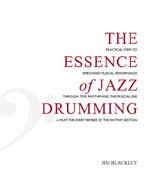I am a staunch disciple of renowned drum teacher Jim Blackley. His death in 2018 at the tender age of 86 silenced his voice, but it needn’t cut us off from his legacy and extraordinary teaching. If there is such a thing as a “Blackley System” then its foundation must be what we find in Section F, which starts on page 97 in Chapter 6 of “The Essence of Jazz Drumming. There are quite a few concepts encapsulated in the chapter, and each addresses a specific issue when applying the drums to jazz and indeed to all music styles.
photo by T Bruce Wittet
3-beat figures played in a 4-beat environment
Cross Rhythms (e.g. 3/4 over 4/4) in jazz is nothing new. Even the lines Jim presents aren’t new. But from humble beginnings, as they say …
Start in “Native Mode”
Play the 3-beat figures on page 98 in 3/4 time to get a feel for them. Once you’re comfortable with the figures in 3/4, you can begin to work them into 4/4 phrases.
2 + 2 Phrases
We can deploy the figures musically by playing two bars of time followed by two bars of the figure. In the case of 3-beat figures, we would play two bars of 4/4 followed by two sets of three plus the first two notes of the figure: 3 + 3 + 2 = 8 beats = 2 bars. A single cymbal stroke on 4 of the second bar helps to set up the figure (Note: this is a classic “call & response” formula).
Counting in 3 & 4
How do you count 3-beat figures when four beats are the norm? It’s important that you can keep the 4/4 straight, so count in four. It’s also important to keep the “3/4” going. Practice counting both ways and you’ll soon be able to switch as needed.
Syncopation
Once the basic 3-beat figures are mastered, we take the concept further by syncopating the figures. In 4/4 time, the syncopated 3-beat figures produce a sonic melange of beats and pulses.
Punctuating Shots using Mnemonics
In jazz, the term “bebop” is derived from a rhythmic figure that is distinctive to that style, i.e. “be-BOP.” Mnemonics like this can help us hear and feel the long and short sounds of the rhythms, resulting in a more musical interpretation.
Playing in 4-bar and 8-bar phrases
Most music is constructed from 4-measure phrases, usually in a 2+2 form often with a call & response motif. An 8-bar phrase is simply two 4-bar phrases. Four and 8 bar phrases are the backbone of (almost) all music, so make a habit of practicing in 4 and 8 bar phrases as much as possible.
Turn-around & Set Up
This section focuses on wrapping up musical phrases with a ‘turn-around.’ A common practice in an 8-bar phrase is to play 6 bars of time followed by a 2-bar figure to close off one phrase and introduce the next one.
Outlining: Shuffle & Triplet Extensions
The technique in this and the remaining sections is called Outlining. You do this by playing a musical statement with one hand -- in this case, the cymbal line -- and then filling in the ‘missing’ notes with the other hand.
Broken Time
A trend that emerged in jazz in the ’60s was to break up the ride pattern. Instead of a steady ‘ding dinga-ding’, drummers began using more space and syncopated figures to produce a looser feel.
Outlining Continued: Inner & Outer Lines
Each pattern has a rhythmic structure, but within that structure there is a second rhythm. In the Rhythmic Extensions (page 103) the cymbal line plays the outer or musical line while the ‘inner line’ is played on the snare with the other hand. This concept can be applied around the set, and any voice can carry either the outer or inner line.
Extended Cross Rhythms
Once you’ve mastered the 2-bar form of the cross rhythm, move on to 4, 8 and 12 bar phrases. The ultimate goal is to be able to play the 3-beat figures for however long you wish to. Note that the patterns resolve every three bars.
Soloing
Soloing with this material is just a matter of taking the outline sticking patterns and moving them around the set. It’s a bit formulaic, but it’s a good way to get the figures working for you. Remember that you have both the outer and the inner lines to play with. To get started, try playing the figures on toms, keeping the inner line on the snare. Experiment with ‘4s’ by playing 4 bars of time and then 4 bars of a figure.
The Essence of Jazz Drumming - “Practical steps to improvised musical performance through time, rhythm and the musical line. A must for every member of the rhythm section”
ISBN: 9780968840603
Available from Drumland: Drumland Canada
For Further Study
If you like this manner of playing, you can take it further by working on the 5-beat figures found in Chapter 11.
Also, I have compiled a list of annotations in a Study Guide to Jim’s game-changing book. Send me an email if you’d like a PDF copy: richard@drumyoda.com .
For more on Jim Blackley:https://en.wikipedia.org/wiki/Jim_Blackley
https://www.thecanadianencyclopedia.ca/en/article/jim-blackley-emc
https://www.pipesdrums.com/article/james-jimmy-blackley-1927-2017/
For more on mnemonics:
https://drumyoda.blogspot.com/2015/07/thoughts-on-comping-part-iv.html







